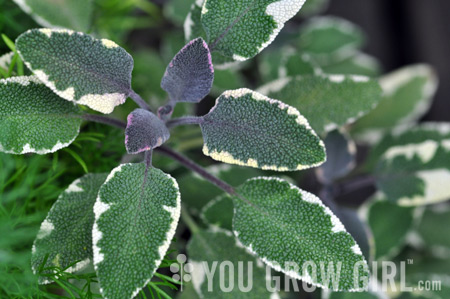My tenth and last Globe & Mail Kitchen Gardening article for the 2010 growing season is set to be published this coming Saturday. It is on growing and eating cardoons, an Italian delicacy that I experimented with this year.
Until then, here’s a timely piece that was published in the Saturday paper on August 27, 2010. Even though the hardy garden sage begins producing leaves very early in the growing season, I most associate its warm aroma with the fall. Sage and squash is a classic combination. I suggest steeping some in oil to drizzle on top of warm squash soup or mash. Bloody good stuff.
————————
Warm and pungent, common garden sage is a classic culinary herb most associated with the flavours of the fall harvest – and now is a great time to plant it. Get yourself a year-old transplant on discount at an end-of-season sale and you should have a small bounty just in time to add to Thanksgiving stuffing, steep in lightly warmed olive oil or drizzle on top of a hearty squash soup.
The sage family is huge, but only a few are edible and even fewer still are cold-hardy enough to survive winter across most of Canada. Like other Mediterranean herbs, they like a sunny spot in the garden and prefer poor, dry soil that drains freely. Keeping their “feet” or roots from stagnating in moist soil is the secret to keeping them alive year-round, especially in climates considered slightly out of their zone. Another trick is to plant sage in the shelter of a warm wall, where it will have the greatest chance of survival.
Whatever you do, resist the urge to fertilize at planting time – or at any time for that matter. Culinary sages grown in rich soil tend to lose their spicy edge and can turn out rather bland leaves that are too “soft” and pest-prone. Otherwise they’re a pretty foolproof plant. My biggest hurdle each year is a mid-summer bout of a fungal disease called powdery mildew that is caused by high humidity around the leaves. Well-draining soil will go a long way to prevention, but, since you can’t control the weather, try plucking out excess foliage (and eating it, too) to increase airflow.
The most common variety (Salvia officinalis) is also the toughest of the bunch. Don’t prune it now. Wait until early spring and cut into the green growth only – never go into the woody stems. At its worst, hard pruning can kill the plant or at least prevent it from flowering – and the edible, slightly sweet flowers are one of the best reasons for growing your own. Toss a few into a spring salad or chop them up and infuse into softened butter or vinegar.
Beyond the common type, the remaining culinary sages won’t live past a year in most Canadian gardens, but are still well worth growing for their unique foliage and varied flavours. ‘Berggarten‘ tastes a lot like common sage but is much prettier, with very broad, oval leaves and a low, densely compact growth habit. ‘Purpurascens,’ ‘Tricolor‘ and ‘Golden’ a.k.a. ‘Aurea’ are the best choice for containers, as they stay compact and adapt well to cramped quarters. In fact, you can even bring one indoors to overwinter on a sunny windowsill for fresh sage year-round.
For something even more unusual, try growing a tropical sage such as ‘Pineapple’ (Salvia elegans) or ‘Fruit’ sage (Salvia dorsiana). Both grow edible, sticky leaves and bold flowers with a fruity, sweet taste that is most often used to make tea or garnish desserts. I’m currently hot on Autumn sage (Salvia greggii), a southwestern salvia that produces delectable, nectar-filled flowers in a wide range of interesting colours from subtle peach to hot pink and the deepest, darkest burgundy. I find the highly aromatic leaves are too bitter to eat, but so delicious to run your hands over on a grey winter day when you can use a boost in spirit and a reminder of the spring to come.

My mom always told me that steeping dried sage makes a great tea for anyone wanting to soothe a very sore throat. Or, if that’s not to your liking, you can gargle with it for the same effect. She was right.
sage is not my favorite for eating, but I love the way it perfumes a room